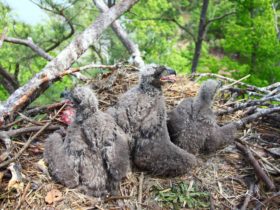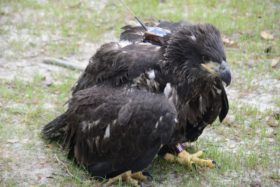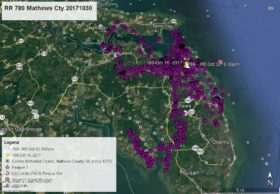A landfill weekend
Azalea Re-Exploring Little Wicomico River
October 13, 2010Azalea Getting Reacquainted
October 25, 2010Libby here filling in for Reese this week.
You may have guessed from the title of this post that the two tracked eagles are currently at landfills. Now I know many of you are disgusted at the thought of this majestic species “dumpster diving.” Bald Eagles have evolved as generalist predators. A majority of their diet is fish but they also commonly eat gulls, ducks, terns, geese, turtles, and scavenged carcasses. Their food choices depend on seasonal availability of their prey, primarily eating fish in the warmer months and birds and carcasses in the cold months when fish are less available. Landfills provide a year-round source of food where eagles visit to forage on trash or concentrated populations of gulls. These landfills may provide young and inexperienced eagles an easy food source until they become proficient at hunting multiple prey types. Following these eagles with transmitters informs us which landfills are getting the most eagle use, and in turn, the ability to investigate possible safety issues at these landfills. While not common, euthanized animals can be improperly disposed of in landfills and any scavenging animals can die of secondary poisoning.
Maps: remember the white circle is the most recent location. The red circles are each hourly location. The orange lines connect each circle and suggest a flight path. Click on each map for a *slightly* larger image.
Azalea and the Saluda Landfill – she visited this landfill many time last year before finding an easier food source at the fish farms in NC.

Camellia and the King George Landfill – he’s been frequenting this location for the past few weeks. We don’t know much about eagle use at this landfill but assume it has visitation because of its close proximity to the Rappahannock and Potomac Rivers. 




6 Comments
Libby, thanks for update. Was your time based on Oct 16th (Wildlife Tracking, latest), or did you download activity ending at some hour today (18th)? or yesterday? Did Azalea cross the river south yesterday?
I was at King George’s Landfill area yesterday afternoon between 2:30 and 5:00. Pretty sure I saw Camellia a few times!! No pics, however. 🙁
Thanks, Libby. Appreciate all the information you pass on to us. Susan
I have visited the King George Landfill on many occasions for work. I have seen as many as 6 eagles at the site at one time. Many of the other large landfills around the state have similar populations.
Thank you Libby for the update. It’s good to know that both eagles are gearing up for the Winter.
Thanx for the update and the insight on landfill feeding!
Thank you for your comments on eagles and landfills. Had been wondering if scavenging at landfills was good for eagles and why they would choose there over fresh fish sources.
You answered most of my questions! Thanks, again.